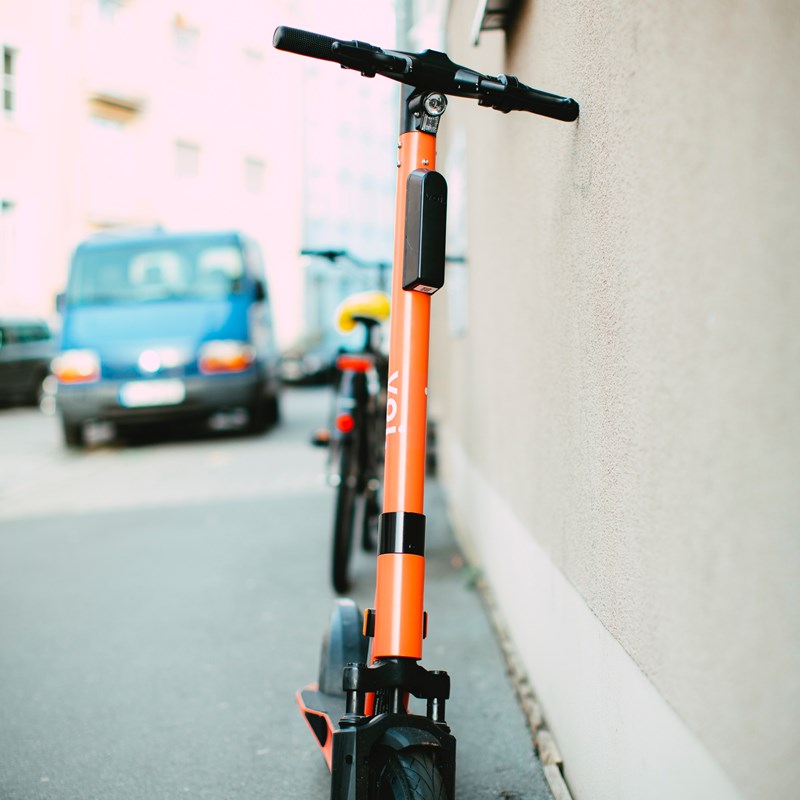
No doubt you’ve seen one go whizzing past as you walk along. Perhaps you’ve tried one out yourself. Before the world was hit by Covid-19, the UK Government was reviewing how to legislate the newcomers to the micro mobility world: e-scooters. Now, in light of the pandemic and the drive to return to work without heavy use of public transport or cars, interest in alternative forms of transport has risen and the Government have brought forward their review.
What are e-scooters?
Updated ‘traditional’ scooters have experienced a resurgence of popularity over the last decade. They have been on the birthday and christmas lists of children across the world, and are a necessity on many school runs! E-scooters are very similar in design; stand up two-wheeled scooters with handlebars. However, they boast a few extra features such as brakes, lights and, most importantly, power. Rechargeable batteries, generally lithium-ion, provide the power. Budget scooters offer around 250 watt-hours (Wh) of charge whilst more expensive models could offer closer to 3000 Wh. Speeds generally range from 10-18mph. Some may be able to achieve higher speeds but for safety they are usually capped between 12.5-15.5mph (15.5mph is the legal speed limit for e-bikes in the UK).
E-scooters have been available for private purchase for quite a while but several factors are prohibitive, namely cost, safety concerns, and confusion over legalities. To buy, they can set you back anything from just over £100 to over £1000.
Back in 2018, e-scooter sharing schemes began to pop up across the globe. Reminiscent of Ofo Bikes and other schemes, these scooters are docklessly accessed and rented by the minute via a smartphone app. The option to rent for a short journey makes them a more viable option.
How safe are they currently?
Part of the micro mobility industry, e-scooters are a relative newcomer. As such, figures are harder to come by. It’s fair to say that as their popularity has risen, so too have accident rates. However, a study on micro mobility safety by the Internal Transport Forum (ITF) found that e-scooters do not pose a higher risk to life than bicycles.
Used on pavements, e-scooters can pose a danger to pedestrians, wheelchair users and people who are visually impaired. When used on roads without infrastructure (such as cycle lanes) there is a general feeling that riders may not be safe. Even when not in use, the scooters can be troublesome; as most sharing schemes are dockless, the scooters can be discarded anywhere, creating a hazard.
And the legalities?
Unsurprisingly, it varies from place to place. In the UK, technically they are illegal, but in May 2020 the Government announced that planned e-scooter trials will be brought forward with the aim of encouraging people to use green alternatives to public transport, especially in light of Covid-19. The trials will be held across the country and will aid the assessment of how the scooters impact public space and the general benefits. Currently, we treat e-scooters as Personal Light Electric Vehicles (PLEVs). Despite this, in general they don’t have visible red rear lights, number plates or the ability to signal. To allow the trials to take place, the government is evaluating this and the long term plan is to regulate them in a similar way to e-bikes.
E-scooter trials
As mentioned, the Government is keen to encourage greener options which eases the strain on public transport. E-scooters could well be a solution. During the trial and until regulations are amended, the only e-scooters that can be legally used anywhere other than private land will be the ones provided for the trials. Across the country, e-scooter companies will work with local authorities to provide rental scooters. Unlocked using an app and paid for by the minute using the same app, riders can use them on the road and cycle lanes/tracks for short journeys. Users must hold a full or provisional driving licence and be over 16. Once the trials are complete and data evaluated, the hope is these scooters will be here to stay, in a regulated fashion.
IoT and micro mobility
E-scooters will be very useful for data collection using the rider’s smartphone and in-built sensors which transmit data to the companies that own them. Details such as journey length, speed obtained, where the scooter is located, which docks require restocking. This information will also aid planning in modern cities providing helpful insights for efficient city design. E-scooter users will benefit from the data through easy access to location information on docks, charging times, security and sharing solutions.
Arkessa offers world-wide multi-network cellular connectivity solutions that get IoT applications off-the-ground and deployed smoothly and efficiently. Get in touch at connect@arkessa.com for further information on our tailored connectivity solutions for connected mobility applications.